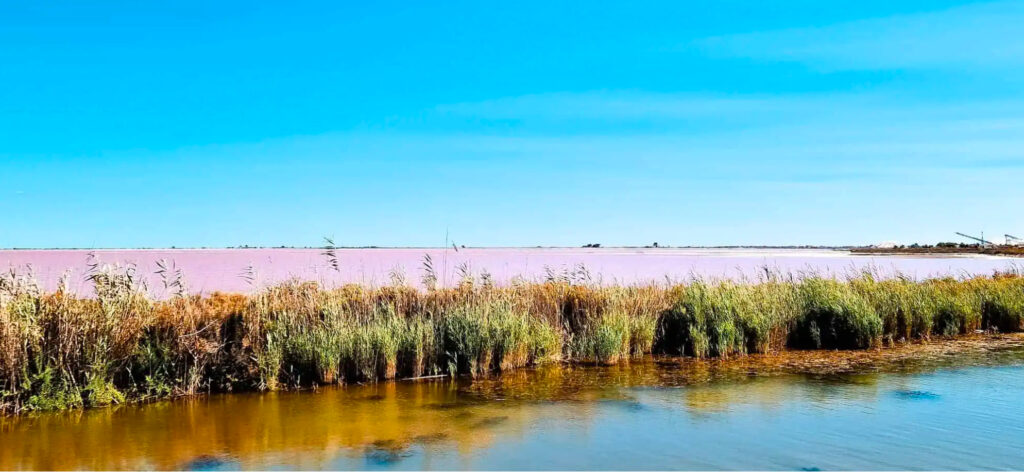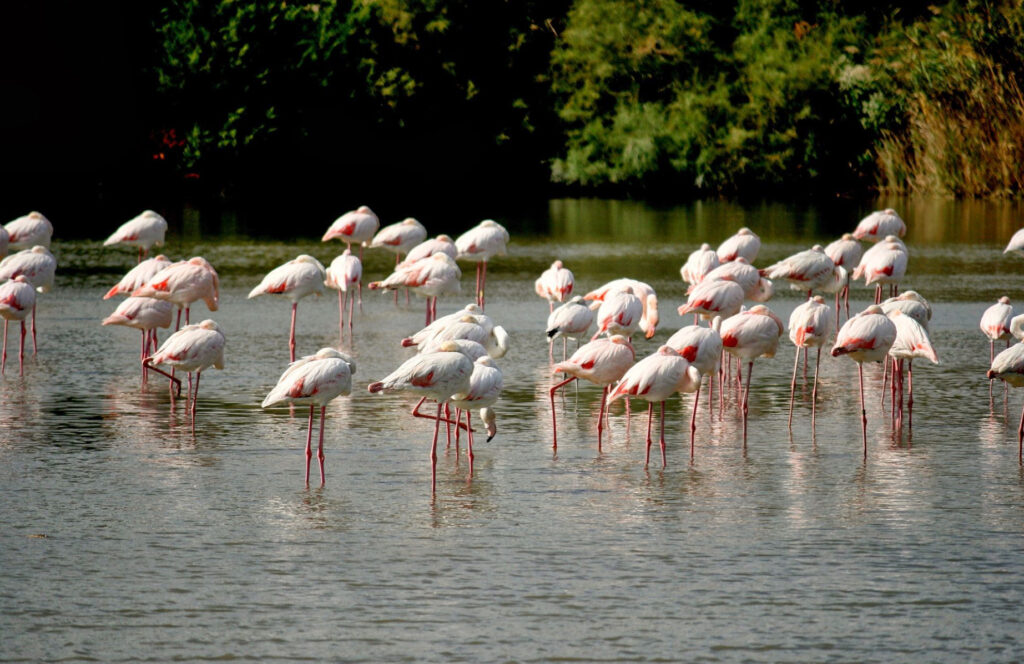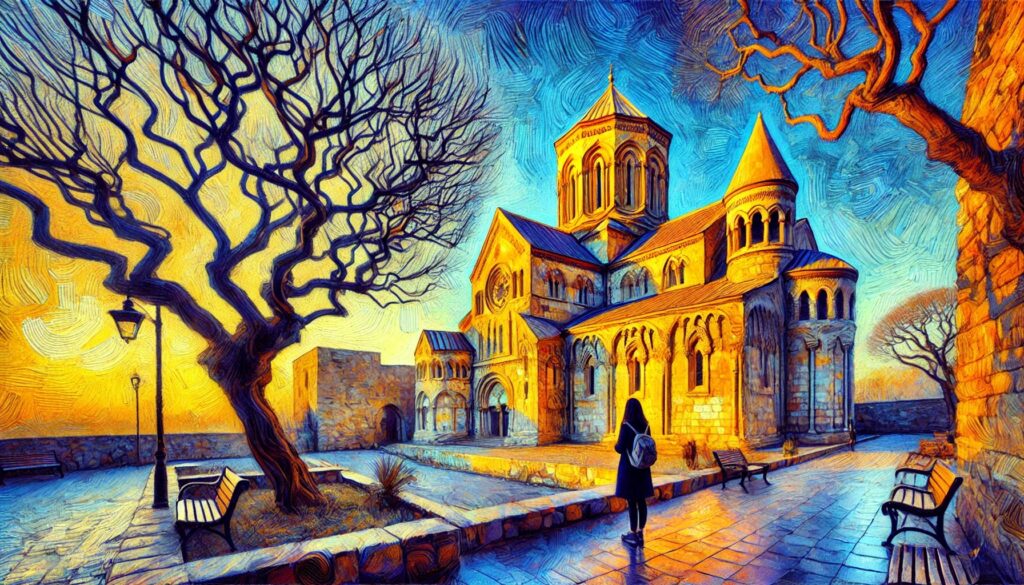ChatGPT:
The Camargue is a distinctive natural region located in the south of France, nestled between the Mediterranean Sea and the two arms of the Rhône River delta, just south of the historic city of Arles. Covering approximately 930 square kilometers (360 square miles), it stands as the largest river delta in Western Europe. The area is renowned for its rich biodiversity, unique landscapes, and cultural traditions that have been preserved over centuries.
Geography and Environment:
- Wetlands and Marshes: The Camargue is characterized by vast expanses of wetlands, salt flats, lagoons, and reed-covered marshes. These habitats are the result of sediment deposition from the Rhône River, creating a flat and low-lying terrain that is periodically reshaped by flooding.
- Salt Flats and Rice Fields: The region’s unique salinity gradients have led to the development of extensive salt flats, known locally as “salins,” which have been utilized for salt production since ancient times. Additionally, the fertile soils support rice paddies, making rice cultivation a significant part of the local economy.
Flora and Fauna:
- Birdlife: The Camargue is a vital sanctuary for bird species, hosting over 400 varieties. It is particularly famous for its population of greater flamingos, which nest in the wetlands. The area is a haven for ornithologists and nature enthusiasts alike.
- Camargue Horses: One of the most iconic symbols of the region is the Camargue horse, considered one of the oldest breeds in the world. These small, sturdy horses are typically white or light gray and are well adapted to the marshy environment.
- Black Bulls: The region is also home to the Camargue bulls, known for their agility and spirit. These bulls are integral to local traditions, especially in bull-running events and festivals.
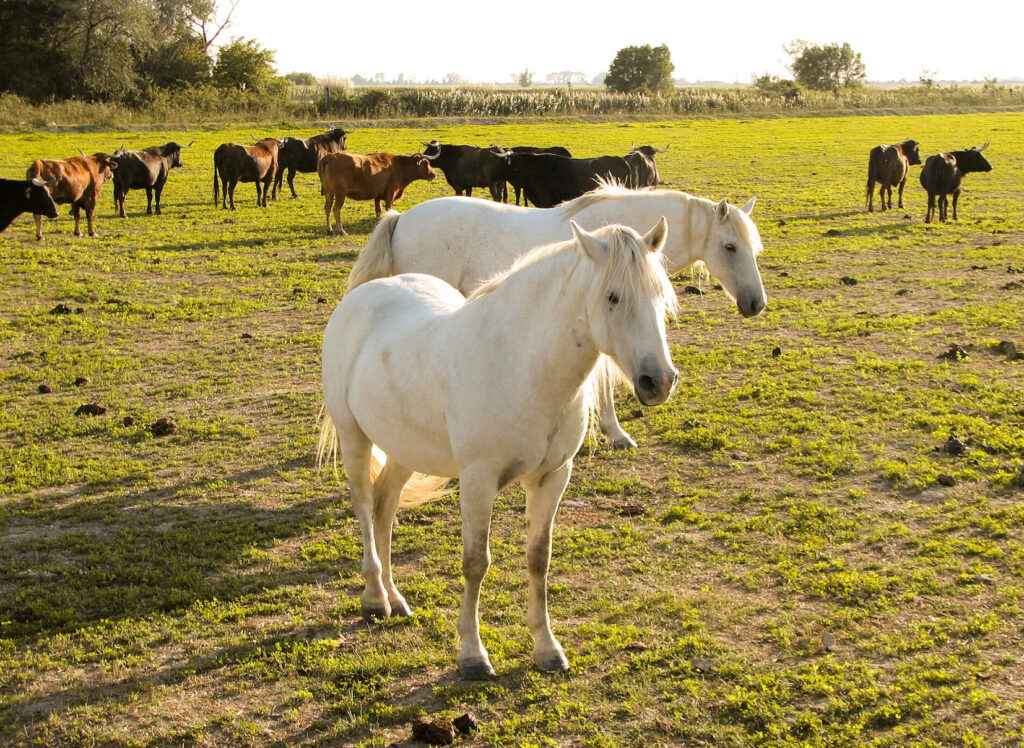
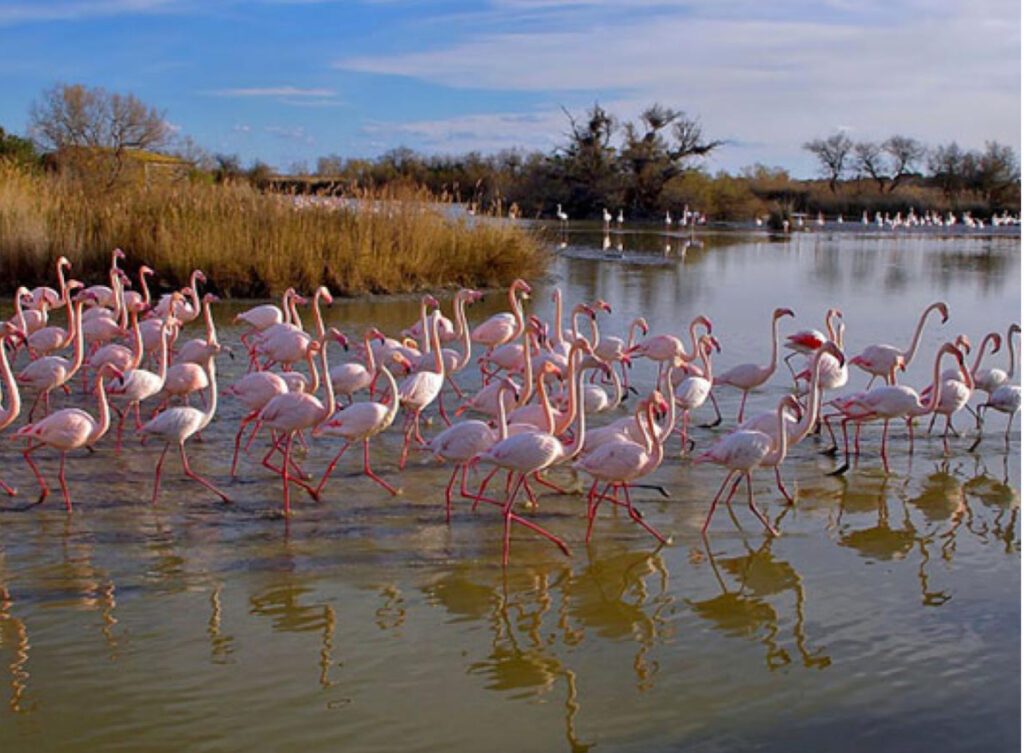
Cultural Heritage:
- The Gardians: Local cowboys, known as “gardians,” are the guardians of the Camargue’s pastoral traditions. They herd the bulls and horses, often dressed in traditional attire, and are central figures in regional festivities.
- Festivals and Traditions: Towns like Saintes-Maries-de-la-Mer host annual festivals that celebrate the region’s cultural heritage. Notably, this town is a pilgrimage site for the Roma community, adding to the area’s rich cultural tapestry.
Conservation Efforts:
- Parc Naturel Régional de Camargue: Established to protect the unique ecosystems, the Camargue Regional Nature Park focuses on conservation and sustainable development. Efforts are made to preserve the habitats that are crucial for the wildlife, particularly the bird species that depend on the wetlands.
Tourism and Activities:
- Nature Exploration: Visitors can engage in birdwatching, horseback riding, and cycling to explore the natural beauty of the region. The diverse landscapes offer opportunities for photography and wildlife observation.
- Cultural Experiences: Tourists can immerse themselves in local traditions by attending festivals, visiting ranches, and learning about the gardian way of life.
Economy:
- Agriculture and Salt Production: Beyond tourism, the economy of the Camargue relies on agriculture—primarily rice cultivation—and salt extraction from the salins.
Significance:
The Camargue represents a harmonious blend of natural splendor and cultural richness. Its wetlands play a crucial role in supporting biodiversity, while its traditions offer a glimpse into a way of life that has endured despite the pressures of modernization. The region is a testament to the importance of preserving natural habitats and cultural identities.
Conclusion:
Whether you’re drawn by the sight of pink flamingos taking flight over shimmering lagoons, the allure of white horses galloping through the marshes, or the vibrant cultural festivals, the Camargue offers a unique and unforgettable experience in the heart of Provence.
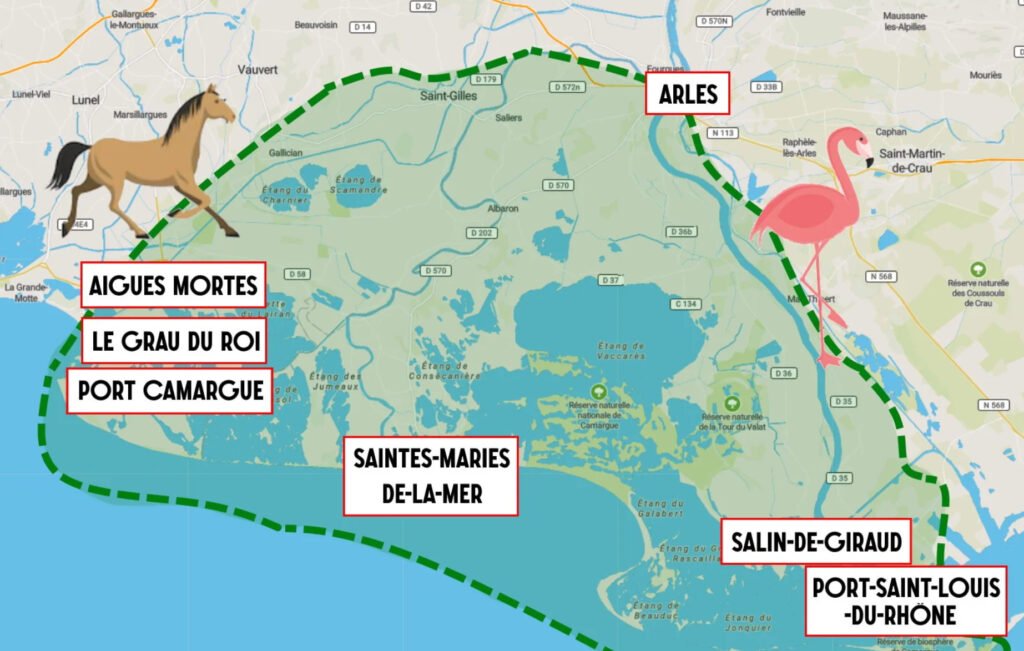
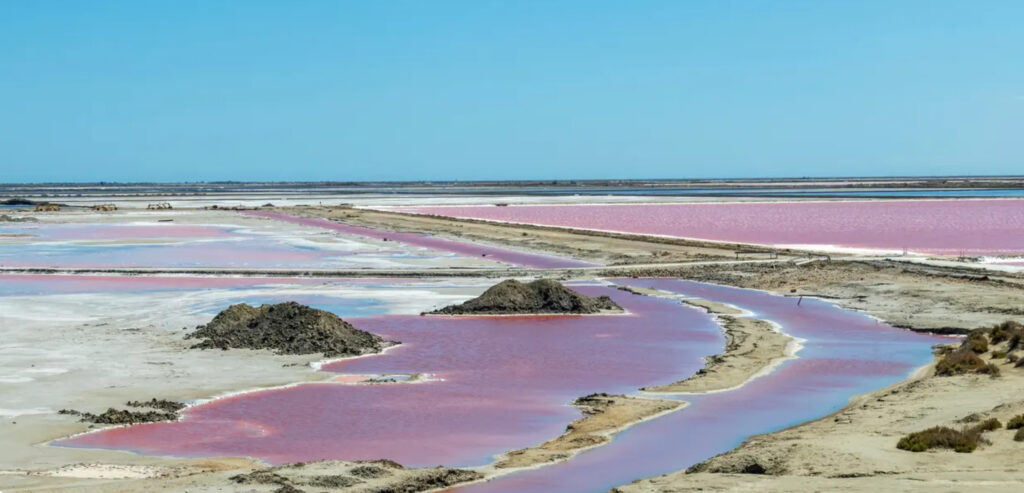
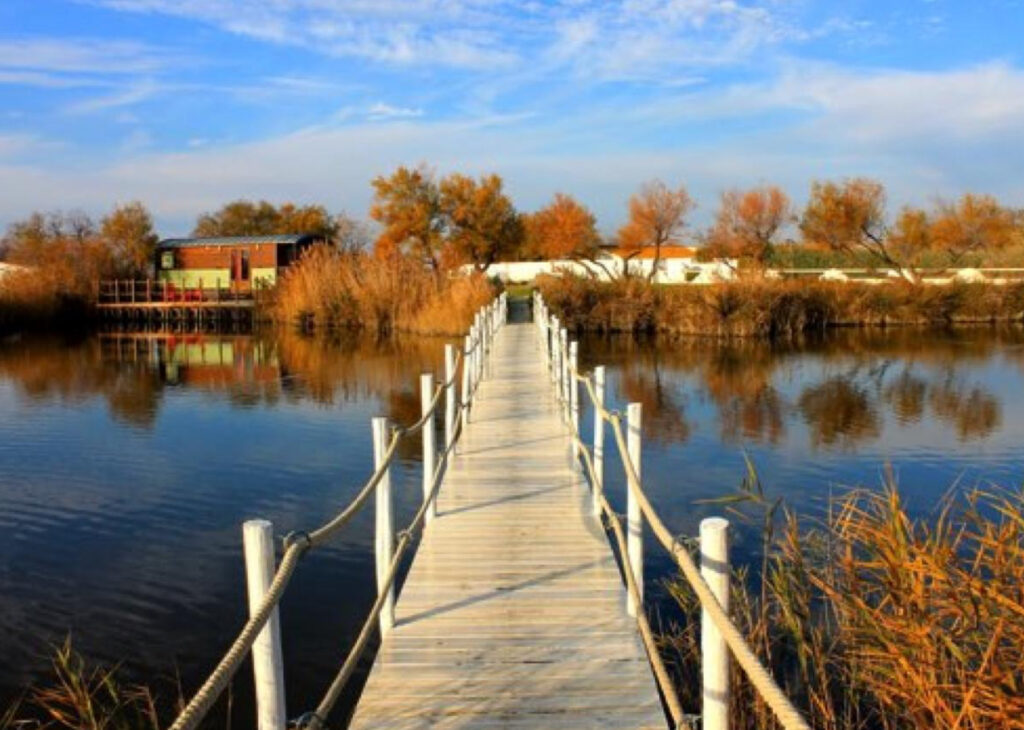
Origin and History of Saintes-Maries-de-la-Mer
Saintes-Maries-de-la-Mer is a small coastal commune located in the Camargue region of southern France, within the department of Bouches-du-Rhône. The town is renowned for its rich tapestry of history, legend, and cultural significance, serving as a pivotal pilgrimage site and a symbol of the region’s diverse heritage.
Ancient Origins
- Prehistoric Settlements: Archaeological evidence suggests that the area around Saintes-Maries-de-la-Mer was inhabited since prehistoric times. Artifacts such as tools and pottery indicate the presence of early human activity, attracted by the fertile lands and abundant resources of the Rhône River delta.
- Greek and Roman Influence: The strategic location near the Mediterranean Sea made it a valuable spot for ancient civilizations. The Greeks established trading posts in the region, followed by the Romans who integrated it into the province of Gallia Narbonensis. Remnants of Roman roads and structures highlight the area’s importance in trade and military movements.
The Legend of the Three Marys
At the heart of the town’s history is the captivating legend of the arrival of the “Three Marys”:
- Mary Jacobe and Mary Salome: According to Christian tradition, after the crucifixion of Jesus, several of his followers fled the Holy Land to escape persecution. Among them were Mary Jacobe (the mother of James the Less) and Mary Salome (the mother of the apostles James and John). Cast adrift in a boat without sails or oars, they miraculously crossed the Mediterranean Sea.
- Arrival in Provence: The boat is said to have landed at the site of present-day Saintes-Maries-de-la-Mer. Their arrival marked the beginning of Christianity in the region, and they spent the remainder of their lives evangelizing in Provence.
- Saint Sarah (Sara la Kali): Accompanying the Marys was their servant, Saint Sarah. Venerated particularly by the Romani people, she is believed to have been of Egyptian origin. “Sara la Kali” translates to “Sara the Black,” and she holds a special place as the patron saint of the Romani. Her inclusion in the legend adds a layer of cultural depth to the town’s heritage.
Medieval Development
- Construction of the Church: In the 9th and 10th centuries, a fortified church was built to honor the saints. The Église des Saintes Maries de la Mer served both religious and defensive purposes, protecting inhabitants from Saracen pirates and invaders. The church is an architectural blend of Romanesque and Gothic styles.
- Pilgrimage Growth: By the Middle Ages, the town had become a significant pilgrimage site. Pilgrims journeyed to venerate the relics of the saints, which were said to possess miraculous healing powers. The town’s religious importance grew, attracting visitors from across Europe.
Cultural Significance
- Romani Pilgrimages: The town is famously associated with annual Romani pilgrimages. Every May, thousands of Romani people from around the world gather to honor Saint Sarah. The festivities include processions where a statue of Saint Sarah is carried to the sea, symbolizing her arrival and the journey of the Romani people.
- Festivals and Traditions: Besides the Romani pilgrimage, the town celebrates the feast days of Mary Jacobe and Mary Salome in late May and October. These events are marked by masses, parades, and traditional Camargue activities like bull running and equestrian displays.
Modern Era
- Economic Shifts: Historically reliant on fishing, agriculture, and salt production, the town transitioned towards tourism in the 20th century. Its unique cultural events, natural landscapes, and historical sites attract visitors year-round.
- Preservation Efforts: Recognizing the importance of its heritage, efforts have been made to preserve the town’s historical structures and traditions. The church underwent restorations, and local authorities work to maintain the balance between tourism and cultural integrity.
Historical Landmarks
- Église des Saintes Maries de la Mer: The fortified church remains the focal point of the town. Visitors can explore its crypt, which houses the relics of the saints, and climb to the rooftop for panoramic views of the Camargue.
- Musée Baroncelli: This museum showcases the history and traditions of the Camargue region, including exhibits on local folklore, costumes, and the lives of the “gardians” (Camargue cowboys).
The Camargue Connection
- Natural Environment: Saintes-Maries-de-la-Mer is set against the backdrop of the Camargue’s unique landscapes, characterized by wetlands, salt flats, and diverse wildlife including flamingos, wild bulls, and the famed white Camargue horses.
- Cultural Fusion: The town embodies a blend of Provençal, Romani, and Mediterranean cultures. This fusion is evident in its music, cuisine, and daily life, reflecting centuries of interaction and mutual influence.
Significance Today
- Pilgrimage and Faith: The town continues to be a vital spiritual center. The pilgrimages reinforce communal bonds and allow for the expression of faith and cultural identity, especially among the Romani.
- Tourism and Economy: Modern amenities coexist with historical sites, offering visitors a chance to experience traditional festivals, nature excursions, and the serene beauty of the Mediterranean coast.
- Cultural Preservation: Local efforts focus on sustaining traditions while accommodating growth. Educational programs and events aim to keep the town’s history alive for future generations.
Conclusion
Saintes-Maries-de-la-Mer stands as a testament to the enduring power of legend, faith, and cultural diversity. From its ancient roots and the evocative tale of the Three Marys to its role as a sanctuary for the Romani people, the town encapsulates a rich historical narrative. Its unique blend of religious significance, cultural traditions, and natural beauty continues to captivate visitors and pilgrims alike, ensuring that the legacy of Saintes-Maries-de-la-Mer endures through the ages.
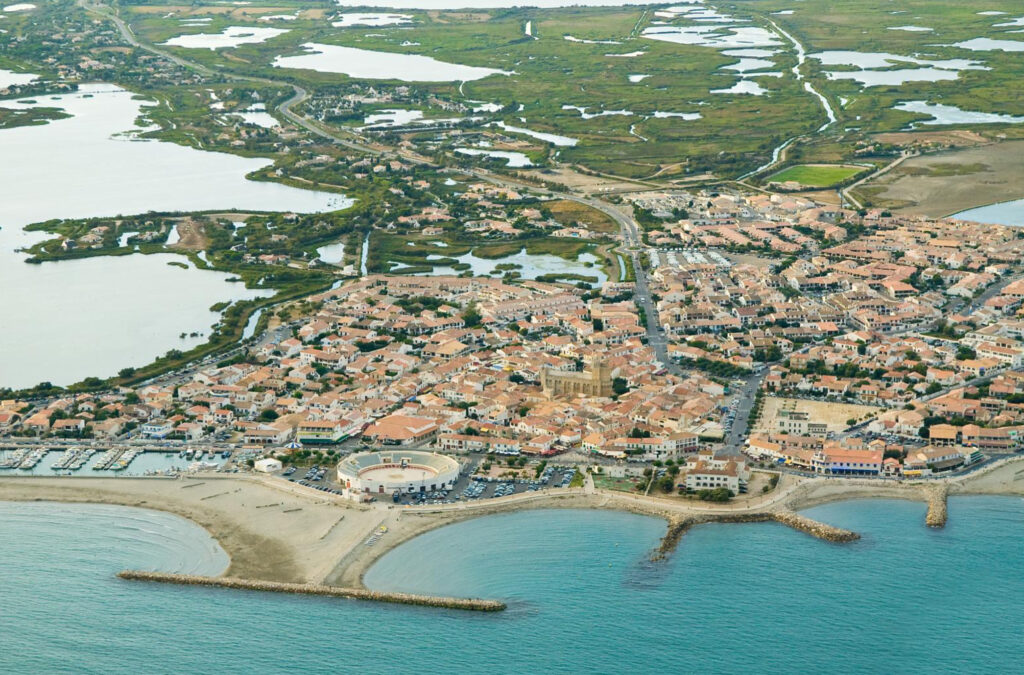
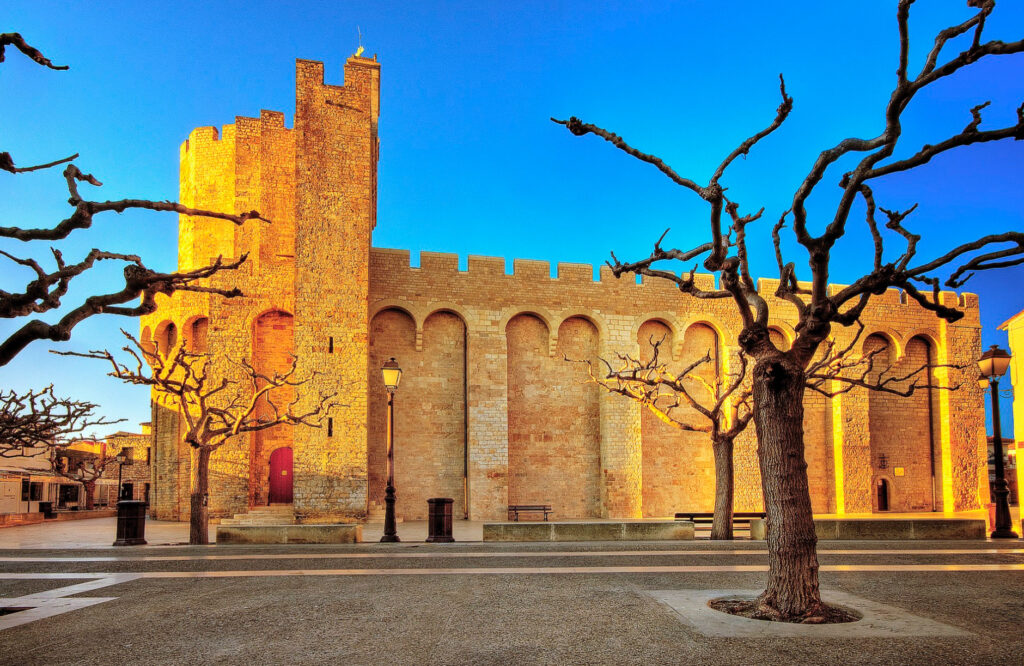
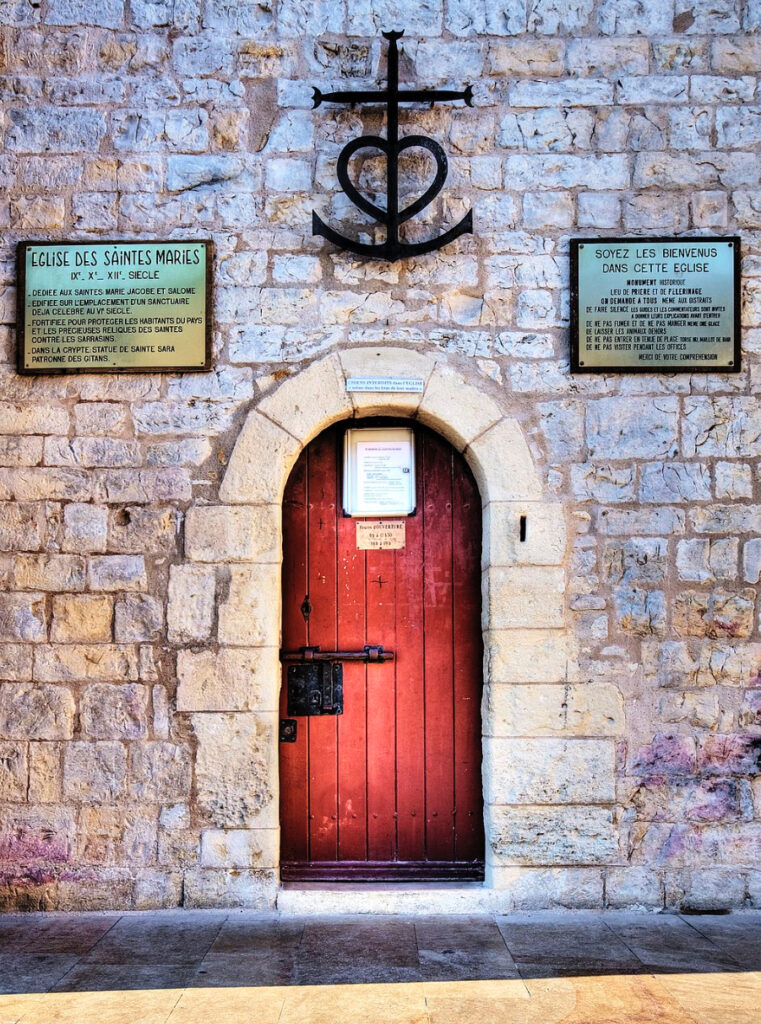
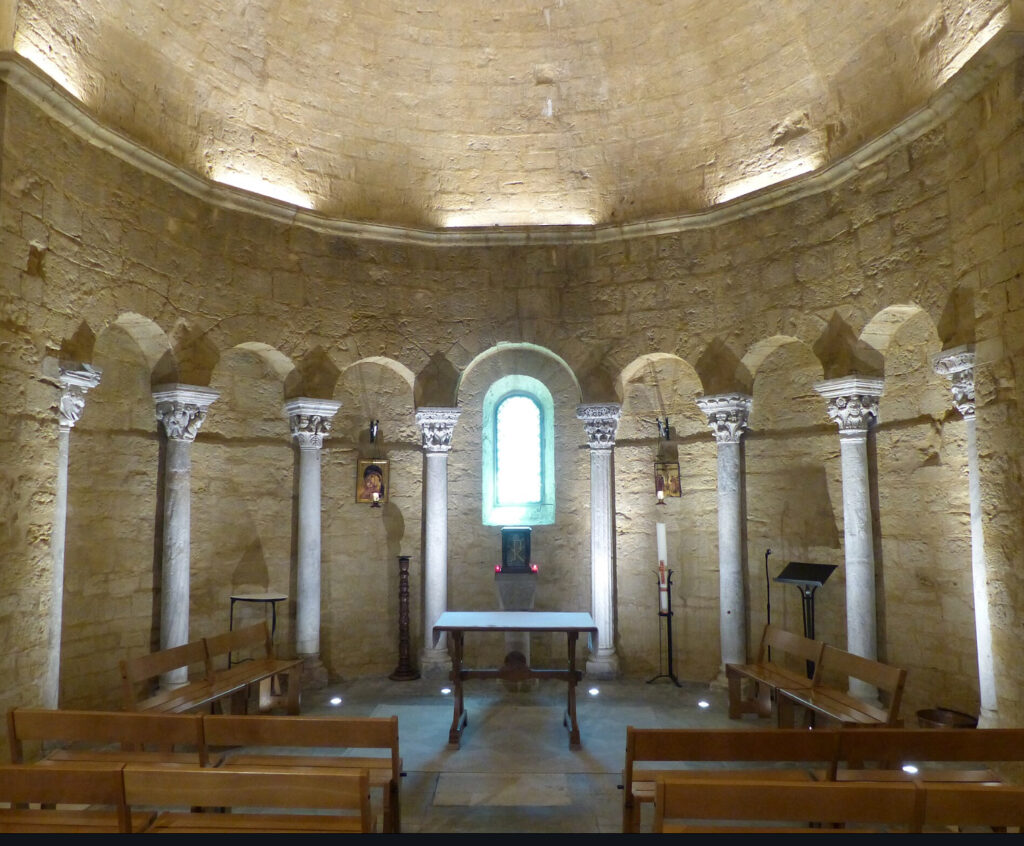
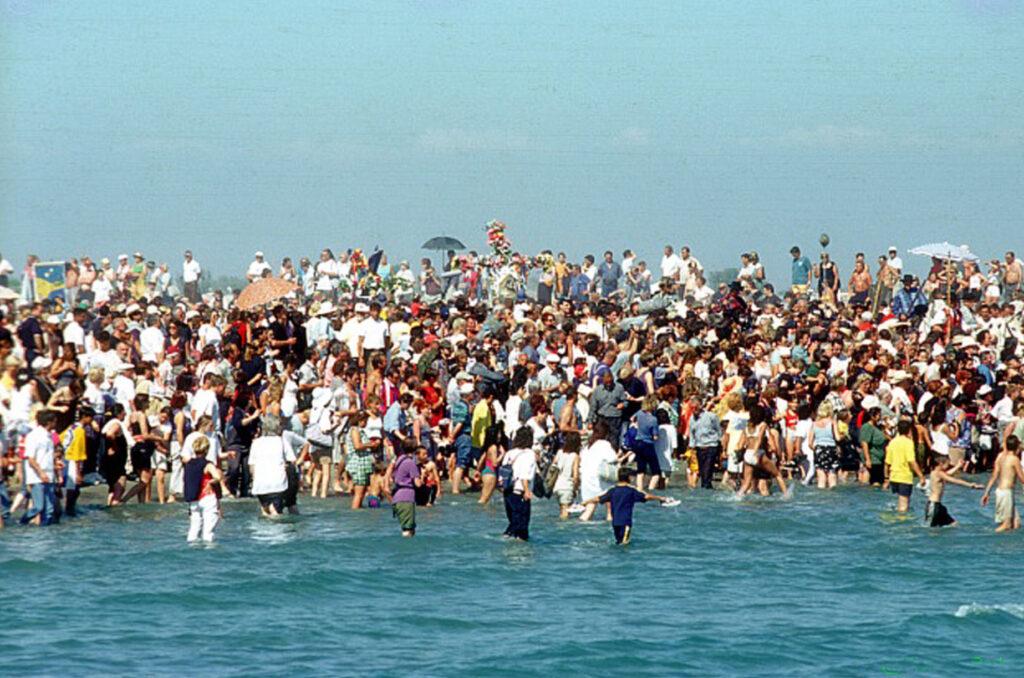
One-Day Itinerary for Exploring the Camargue Region
Experience the unique blend of nature, history, and gastronomy that the Camargue has to offer with this one-day itinerary designed for nature and history enthusiasts.
Morning
7:30 AM – Start Your Day in Arles
- Breakfast: Begin with a traditional French breakfast at a local café in Arles. Enjoy fresh croissants, baguettes with jam, and a café au lait to energize for the day ahead.
8:30 AM – Visit the Parc Ornithologique du Pont de Gau
- Location: Approximately a 30-minute drive from Arles.
- Activity: Explore this renowned bird park where you can observe the Camargue’s diverse birdlife in their natural habitat.
- Highlights:
- See pink flamingos, herons, egrets, and over 200 other bird species.
- Walk along the well-maintained trails and boardwalks through marshes and lagoons.
- Tip: Early morning is the best time for bird activity and photography.
Mid-Morning
10:30 AM – Explore Saintes-Maries-de-la-Mer
- Activity: Arrive at the historic coastal town known for its rich history and cultural significance.
- Visit Église des Saintes-Maries-de-la-Mer:
- Explore the fortified church dating back to the 9th century.
- Climb to the rooftop for panoramic views of the town and the Mediterranean Sea.
- Visit the crypt dedicated to Saint Sarah, revered by the Romani people.
- Stroll Through the Old Town:
- Wander the narrow streets lined with whitewashed houses.
- Browse local artisan shops selling souvenirs, crafts, and regional products.
- Experience the vibrant atmosphere of this seaside town.
Lunch
12:30 PM – Savor Traditional Camargue Cuisine
- Restaurant Suggestions:
- Le Bruleur de Loups: Known for its rustic ambiance and local dishes.
- La Bouvine: Offers a menu featuring regional specialties.
- Cuisine Highlights:
- Gardianne de Taureau: A hearty bull meat stew cooked in red wine and herbs.
- Tellines: Small clams sautéed with garlic and parsley.
- Camargue Rice: Sample dishes made with the area’s famous red rice.
- Beverage: Pair your meal with a glass of local Costières de Nîmes wine.
Early Afternoon
2:00 PM – Horseback Riding Through the Camargue
- Activity: Experience the natural beauty of the Camargue on horseback.
- Booking: Arrange a guided tour with a reputable ranch such as:
- Les Cabanes de Cacharel
- Promenade à Cheval La Marisma
- Highlights:
- Ride through wetlands, salt flats, and along the beach.
- Encounter wildlife like wild horses, bulls, and various bird species.
- Learn about the region’s ecology and traditions from your guide.
- Duration: Tours typically last about 2 hours.
- Tip: Wear comfortable clothing and closed-toe shoes.
Late Afternoon
4:30 PM – Visit the Salt Flats (Salins du Midi)
- Location: Near the town of Aigues-Mortes, a 30-minute drive from Saintes-Maries-de-la-Mer.
- Activity: Explore the striking pink salt pans and learn about salt harvesting processes.
- Guided Tour: Take a small train tour or walk along designated paths.
- Photography: Capture the vivid colors and reflections in the salt flats.
- Alternative: If interested in history, visit the medieval town of Aigues-Mortes.
- Highlights:
- Walk along the well-preserved ramparts.
- Visit the Tower of Constance.
- Learn about the town’s role during the Crusades.
Evening
6:30 PM – Return to Saintes-Maries-de-la-Mer
- Sunset at the Beach:
- Relax on the sandy shores and enjoy the sunset over the Mediterranean.
- Ideal spot for reflection and appreciating the day’s experiences.
7:30 PM – Dinner Featuring Local Specialties
- Restaurant Suggestions:
- Le Petit Gourmet: Offers a cozy atmosphere with regional dishes.
- L’Asti: Known for fresh seafood and waterfront views.
- Cuisine Highlights:
- Bouillabaisse: A traditional Provençal fish stew.
- Anchoïade: A dip made from anchovies, garlic, and olive oil, served with raw vegetables.
- Dessert: Try Fougasse d’Aigues-Mortes, a sweet bread flavored with orange blossom.
- Entertainment: Some restaurants feature live music, especially during summer months.
Nightcap and Stroll
9:00 PM – Explore the Nightlife
- Activity: Take an evening stroll through the illuminated streets.
- Enjoy street performances or local music.
- Visit a wine bar to sample regional wines like Rosé de Provence.
10:00 PM – Depart or Stay Overnight
- Option to Stay:
- If you prefer, book a room at a local hotel or guesthouse to extend your stay.
- Departure:
- Alternatively, drive back to Arles or your accommodation to conclude the day.
Additional Tips
- Transportation: Renting a car is recommended for flexibility.
- Wildlife Etiquette: Maintain a respectful distance from animals and follow guidelines in protected areas.
- Dress Code: Wear layers and bring sun protection; the weather can change quickly near the coast.
- Reservations: Book tours and restaurant tables in advance, especially during peak season (May to September).
- Local Markets: If time permits, visit local markets for regional products like salt, rice, honey, and crafts.
Conclusion
This itinerary offers a rich blend of the Camargue’s natural wonders, historical sites, and culinary delights. From observing flamingos in their wetland habitats to walking the historic streets of Saintes-Maries-de-la-Mer and indulging in local specialties, your day will be filled with memorable experiences that capture the essence of this unique region.
